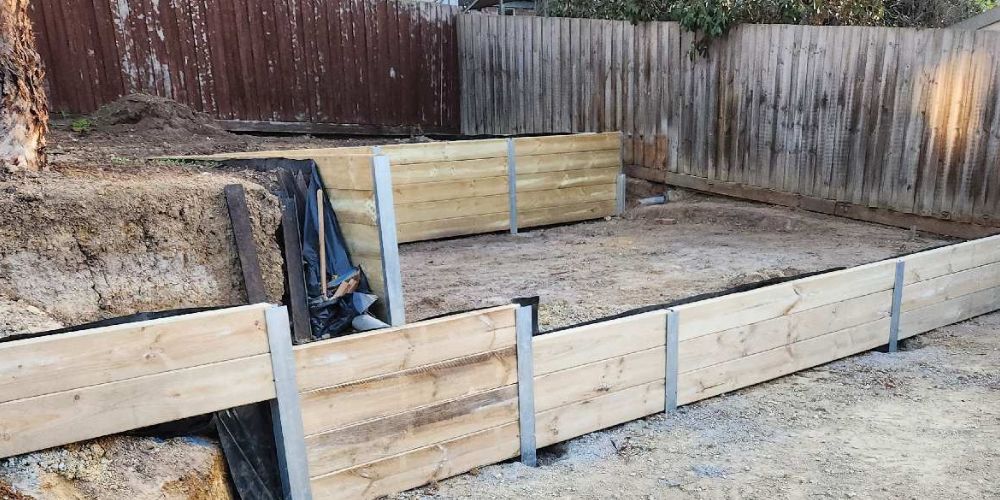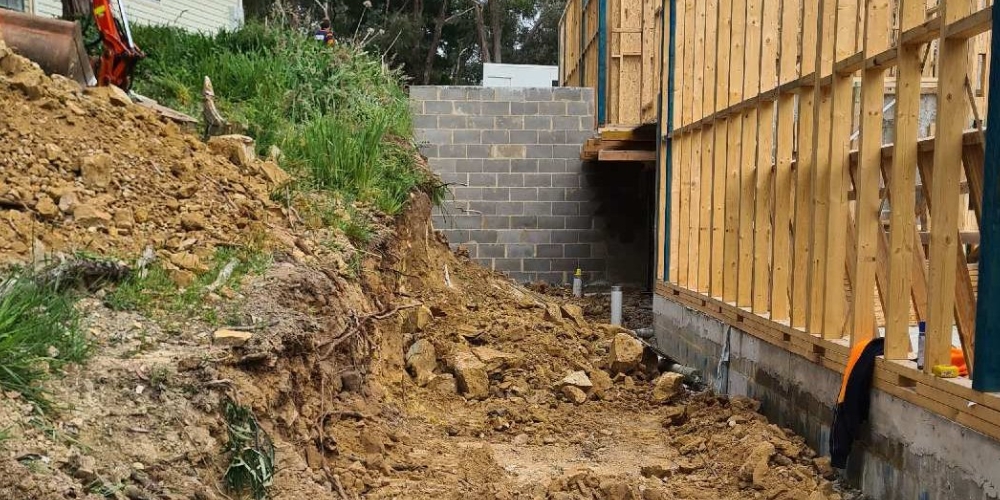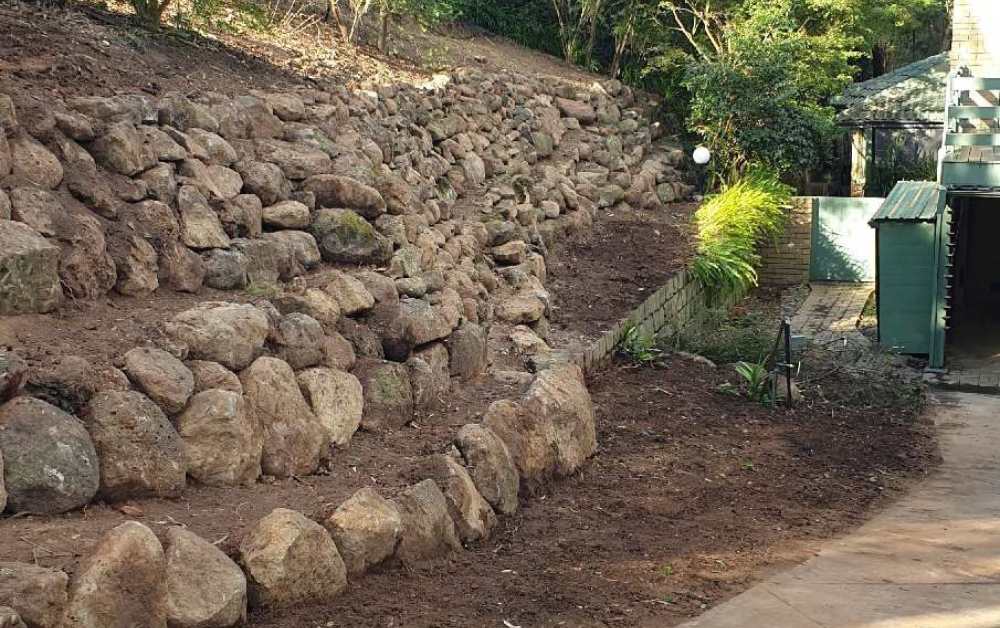Do I Need My Neighbor’s Permission to Build a Retaining Wall?
So, everything was set. The budget, the builder, the contract. And then you realise the retaining wall you plan to build is right on the property line, adjacent to your neighbour’s land. The question that suddenly looms over your excitement is, “Do I need my neighbour’s permission to build a retaining wall?”
Well, of course. As a sign of courtesy and good neighbourly relations, seeking your neighbour’s permission before embarking on a retaining wall project is not just a gesture; it’s a crucial step in avoiding potential conflicts.
Retaining walls, while serving practical purposes like preventing soil erosion and managing landscape elevations, can significantly impact the aesthetics and shared space between properties.

Why Does Everyone Need a Retaining Wall?
Let me tell you, these things are like superheroes for your yard. “Why on earth does everyone need a retaining wall?” you ask. Here’s the skinny, put and plainly:
Keeping the Ground in Check
Think of your garden like a rollercoaster ride with some shakiness. When the ground moves too much, a retaining wall intervenes, saying, “Hold up, I got this!” This is great because it holds everything in its proper place.
Getting Things to Look Nice
These walls are like a makeover for your yard—they’re not simply useful. They define distinct sections and give your home a polished appearance, making it orderly and organised. It’s like getting a trendy haircut for your yard—an instant makeover!
Stopping the Soil Shuffle
The last thing you want isyour soil to vanish during a downpour. That soil cannot escape thanks to a retaining wall. It’s similar to having a reliable friend who ensures everything gets done, rain or shine.
Creating Cool Hangout Spots
Do you have unsightly areas in your garden that you need help handling? Well, a retaining wall makes them into fun places to hang out. Consider it as an addition to a little patio for your parties or simply a peaceful area to relax in.
Preventing Surprises in Your Basement
Should your backyard be slightly sloping, precipitation may choose to divert and end up in your basement. Like a bouncer, redirecting that water away from your property is what a retaining wall does. It functions as a personal guardian against surprises for your house.
Should You Ask Neighbor's Permission Before Building a Retaining Wall?
Not only is it polite to ask your neighbour’s permission before installing a retaining wall, but it can also help you avoid future disputes and legal problems. Before beginning your retaining wall project, you should think about talking to your neighbours for the following main reasons:
Respecting Shared Boundaries
If you build a retaining wall on the boundary of your property, it may have an impact on your neighbour’s area. You can establish open lines of communication and demonstrate respect for mutual boundaries by asking for their consent.
Avoiding Legal Hassles
Local authorities frequently require property owners to obtain their neighbour’s approval when constructing projects close to shared property borders. Noncompliance may result in fines, legal issues, or the need to tear down the wall.
Mitigating Potential Disputes
Building a retaining wall without informing your neighbour may cause miscommunications and conflicts. You can discover common ground and address any worries they may have by outlining your plans in advance.
Collaborative Decision-Making
Whether the retaining wall is a shared construction or will serve both properties, involving your neighbour in the decision-making is important. Working together makes it possible to ensure everyone agrees regarding the wall’s design and purpose.
Building Positive Neighbor Relations
Your house is a part of a community, not just a building. Getting permission from your neighbour promotes goodwill. It is an opportunity to demonstrate respect for their choices and promote a welcoming neighbourhood environment.
Sharing Project Details
Discussing your retaining wall plans with your neighbour lets you share important project details. This might include the intended design, construction timeline, and any potential disruptions during the building process. Transparency can alleviate concerns.

When do you need your neighbour's permission?
Knowing when you need your neighbour’s permission is crucial when planning to build a retaining wall. Here are some key situations that warrant reaching out to your neighbour:
Close to the Property Line
Talk to your neighbour first if you’re considering building a retaining wall along or along your property line. Checking to be sure they approve of it makes sense, particularly if it could impact their portion of the land.
Shared Wall Construction
I recommend having a heart-to-heart conversation with your neighbour regarding a retaining wall that will serve your properties. Remember that having shared walls entails making decisions together, so you want to be sure you both approve of how it will seem and work.
Local Regulations Mandate It
Check your community’s zoning regulations; it’s possible that some building projects, such as retaining walls near property lines, require neighbour approval. It is usually advisable to abide by the guidelines.
Possible Effect on Their Land
Let your neighbour know if your retaining wall might cause disturbances on their property, such as shifting soil, interfering with water drainage, or casting shadows. Getting their blessing is akin to building a friendly fence to avoid future problems.
Construction Involves Excavation
Have excavation work scheduled for your project with a retaining wall? Good! However, before the equipment hums, be a good neighbour and send your neighbour a brief message. It’s all about exercising consideration and averting unforeseen disruptions.
Constructing a Common Fence
How great would it be to have your retaining wall serve as a shared fence and a barrier? Get your neighbour involved in the decision-making to make it even more awesome. You both want to be happy with how it works out, I promise.
Community or Homeowner's Association Guidelines
Your homeowner’s association has some rules; you need your neighbour’s thumbs up for retaining walls. Following these guidelines isn’t just about checking boxes; it’s about fostering a positive vibe in the community.
Who Pays for a Retaining Wall Installation and Repair?
Costs of Installation
The property owner is usually responsible for installing a new retaining wall. You will be responsible for paying for the design, materials, labour, and any required permits if you are the one who wants the wall. Since it’s your vision, the cost falls on you.
Shared Walls, Shared Costs
It might make sense to split the cost of the retaining wall, which benefits both your property and your neighbour’s. When there are shared walls, the costs are typically split amongst the property owners that use the structure. Here, communication is key. To minimise surprises, go over the schedule and costs in advance.
Legal Nudges
Legal requirements may also apply. Regulations in some places may stipulate that costs associated with retaining walls that benefit multiple properties must be divided. You can anticipate legal pressures towards joint financial responsibility by looking up local zoning rules.
Repair and Maintenance
In most cases, the cost of repairs falls on the property owner whose retaining wall requires attention. You must have the wall repaired if it is on your property and begins to exhibit signs of deterioration. Frequent maintenance can assist in identifying problems early and avert expensive future repair costs.
Neighborly Agreements
While the law frequently specifies who is responsible for what, occasionally, amicable agreements suffice. If a retaining wall benefits both parties, even though it’s not required by law, neighbours may choose to split the costs in some situations. Cooperation and open communication can result in agreements that benefit both parties.

How To Avoid Conflicts With Your Neighbor - Our Expert Tips
Maintaining positive relationships with neighbours is crucial, especially when undertaking projects like building a retaining wall.
Here are our expert tips on how to avoid conflicts and foster good relations:
Open Communication
The key is communication. Have an honest discussion with your neighbour before beginning the retaining wall project. Talk about your plans, give them the project specifics, and answer any worries they might have. Openness fosters trust.
Explain the Advantages
Clearly state the retaining wall’s advantages. Whether avoiding soil erosion, improving aesthetics, or offering structural support, making the benefits clear to your neighbour can encourage cooperation and reduce anxiety.
Check Local Regulations Together
Together, go over the local building codes and zoning rules. Comprehending the legal criteria guarantees mutual agreement and can prevent disputes with property limits or construction regulations.
Establish a Construction Timetable
Work together to create a construction schedule if there will be disruptions due to construction. Notify your neighbour of the anticipated traffic, noise levels, and difficulties. A well-communicated plan reduces surprises and shows consideration for their privacy and peace.
Express Gratitude
After completing the project, express gratitude to your neighbour for their cooperation. A simple thank-you note or gesture shows appreciation and reinforces a positive relationship. This lays the foundation for continued goodwill and collaboration.
What If My Neighbour Refused to Cooperate?
Dealing with a neighbour off-board with my retaining wall plans is quite a hurdle. First, seek mediation – involving a neutral third party can be a game-changer. Understanding what’s bugging your neighbour is key, so Open a chat to hear them out and see if we can find a middle ground.
Checking the local zoning laws is necessary to ensure your project is on solid legal ground. Talking to an attorney might be the next step if things don’t budge. Keeping a record of all our exchanges is handy in case things get legal.
Exploring alternative solutions that could ease your neighbour’s worries is on your radar, and if push comes to shove, check out any local dispute resolution options available. It’s all about patience, communication, and finding that sweet spot where both parties can be happy.
Frequently Asked Questions
Even if you can construct on your land, it’s still a good idea to let your neighbour know so that you can keep things cordial and prevent any future conflicts.
Building a shared retaining wall without permission may result in fines, legal problems or even the need to demolish or alter the construction. It is essential to follow local laws and look for cooperation.
Yes, consensus on design components may be necessary when sharing walls. Working together guarantees that both sides are satisfied with the aesthetics and functionality of the retaining wall.
Exploring alternative materials or designs that address your neighbour’s concerns can be a proactive approach, promoting collaboration and goodwill. Some options to explore include using aesthetically pleasing materials, incorporating greenery, or opting for modular and less imposing structures that seamlessly integrate into the landscape.
Conclusion
Establishing good relationships, knowing local laws, and maintaining open lines of communication are all crucial for navigating the process of erecting a retaining wall next to your neighbour’s land. Open communication is essential when asking for permission, splitting expenses, or resolving issues.
Remember that there is no one-size-fits-all approach because every scenario is different. Treat your neighbour with decency, keep up with local legislation, and be willing to reach a compromise. Doing this contributes to a peaceful living environment in your community and improves your property’s functioning and aesthetics.
